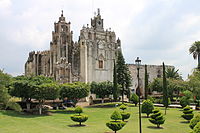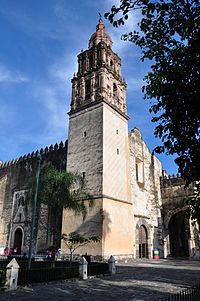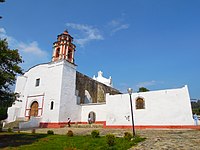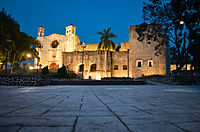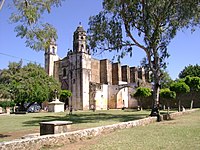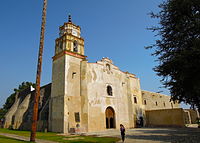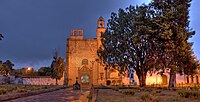Monasteries on the slopes of Popocatépetl
| Earliest monasteries on the slopes of Popocatépetl | |
|---|---|
 View of the church façade of the monastery in Tepoztlán | |
| Location | Areas south and east of Popocatépetl, Mexico |
| Built | 16th Century |
| Built for | The Augustinians, the Franciscans and the Dominicans |
| Type | Cultural |
| Criteria | ii, iv |
| Designated | 1994 (18th session) |
| Reference no. | 702 |
| Region | Latin America and the Caribbean |
The Earliest Monasteries on the Slopes of Popocatepetl (Spanish: Primeros Monasterios en las faldas del Popocatépetl) are sixteen earliest 16th-century monasteries which were built by the Augustinians, the Franciscans and the Dominicans in order to evangelize the areas south and east of the Popocatépetl volcano in central Mexico. These monasteries were recognized by the UNESCO as World Heritage Sites in 1994, because they served as the model for the early monastery and church buildings as well as evangelization efforts in New Spain and some points beyond in Latin America. These monasteries almost uniformly feature a very large atrium in front of a single nave church with a capilla abierta or open chapel. The atrium functioned as the meeting point between the indigenous peoples and the missionary friars, with mass for the newly converted held outdoors instead of within the church. This arrangement can be found repeated in other areas of Mexico as these friars continued to branch out over New Spain.
The sixteen monasteries are open to visitors, with eleven located in northern
Region
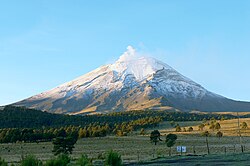
The World Heritage Site consists of sixteen monasteries that are located south and east of the city of Mexico, the majority in the state of Morelos, except three that are in the state of Puebla. The monasteries in Morelos are located in the municipalities of Atlatlahucan, Cuernavaca, Tetela del Volcán, Yautepec, Ocuituco, Tepoztlán, Tlayacapan, Totolapan, Yecapixtla and Zacualpan de Amilpas. The three in Puebla are located in Calpan, Huejotzingo and Tochimilco. Most of these monasteries are located on the outskirts of Popocatépetl volcano.
Although Popocatepetl is an active volcano, none of the monasteries have been affected by this activity, although some have been damaged by seismic activity. The danger of the volcano is low in these monasteries and in the more than one hundred historical monuments of the region, because in this area there are low lava flows from the volcano and because the monuments were not built in areas where lava tends to run.
World Heritage Site
The
They were declared a World Heritage Site on 17 December 1994, due to being the model for monasteries and evangelism on the American Continent.[4] They represent the adoption of an architectural style by the first Franciscan, Dominican and Augustinian missionaries, which included the use of open outdoor space. This use of open space in the planning of churches and monasteries was adopted through most of Mexico and in some other parts of Latin America.[2] There is disagreement as to whether the monasteries represent a complete imposition of European design or whether they adopted certain aspects of indigenous ceremonial spaces. However, the use of open chapels and “capillas posas” or atrium corner chapels, in large atriums were a way of accommodating the first indigenous converts, who were not used to entering large enclosed structures. The atrium became essential as the meeting point between the evangelists and the indigenous.[5]
The sixteen were built at the very beginning of the evangelization period after the
In Puebla, there are three: San Francisco de Asís in San Andrés Calpan, San Miguel Arcángel in Huejotzingo and Asunción de Nuestra Señora in Tochimilco.[7]
After the sites' being named as a World Heritage Site, the Instituto Nacional de Antropología e Historia, (INAH) pledged millions of pesos for the restoration and preservation of eleven of the monastery sites. Much of the money was targeted to problems caused by humidity in the walls. One of the first projects was to restore the mural work in the Tetela del Volcán monastery. Another early project was to restore the gardens and fields of the Atlatlahucan monastery. These fields now produce avocados and other crops which are sold to help fund maintenance.[8]
Over 70% of the monasteries built in the 16th century are still in good condition.
Despite Popocatepetl's being an active volcano, none of the monasteries have been damaged by it, although some have been damaged by earthquake activity. Volcano danger to these and the over 100 other historical monuments in the area is low because lava flows from the volcano are generally slow and monuments were not built in the low-lying areas that lava tends to run to.[10]
To further publicize the World Heritage monasteries in Morelos, the state promotes the eleven as the Route of the monasteries or the Route of the Volcano. The route begins in Cuernavaca with the monastery church serving as the city's cathedral. The route then moves east and somewhat north through Tepoztlán, Oaxtepec, Tlayacapan, Totolapan, Atlatlahuacan, Yecapixtla, Ocuituco, Tetela del Volcán and Hueyapan before ending in Zacualpan de Amilpas.[11][12]
Monasteries
The sixteen 16th-century monasteries listed by
Common elements

The reason for being a World Heritage site is that the construction of these monasteries served as an architectural and urban planning model for the monasteries and towns that followed.[6] These monasteries were built to be very solid with thick walls and had a very austere aspect.[14] In some of the complexes, one can see stone merlons which make the complexes look like castles or forts. These were for defensive purposes, as the monks were invading Mesoamerican lands to impose a new religion. For this reason, churches and monasteries of this type are called “fortress temples.”[3]
Most of the monasteries have a large atrium in front of the church, an open chapel, four chapels in each corner of the atrium, and atrium cross, Stations of the cross on the atrium walls, a roofed church, and the cloister area for the monks.
The large-roofed churches have only one name and on one side, usually on the south, is the cloister area for the monks. Most of the cloisters have or had murals, large gardens and fountains.[5][6] Decorative elements in both vary, often mixing different trends that were prevalent in Europe at the time, such as rose windows common on French cathedrals, portals similar to those in Spain and even Islamic style triangular altars.[3] A number of hidden elements such as certain numbers important to native beliefs can be found in the churches, such as the number of stairs and aspects of the decorative figures. It is unknown whether these were tolerated by the friars or whether they were added clandestinely.[5]
History

The monasteries are part of the history of the early evangelization of Mexico. The Franciscans were invited to come first by Hernán Cortés, followed shortly thereafter by the Dominicans and the Augustinians. After establishing themselves in Mexico City and in the rest of the Valley of Mexico, they evangelized the area south and east of the volcano. The missionaries included Juan de Tecto, Juan de Ayora and Pedro de Gante, the last of whom learned Nahuatl in order to communicate with the indigenous peoples.[4] The first of the monasteries were built by the Franciscans in 1524, who founded the monasteries of Huejotzingo, Cuernavaca, Calpan and Tochimilco. The Dominicans followed in 1526, founding those in Oaxtepec, Tepoztlan, Tetela del Volcán and Hueyapan. The Augustinians arrived in 1533 and founded the monasteries in Ocuituco, Totolapan, Yecapixtla, Tlayacapan, Atlatlauhcan and Zacualpan de Amilpas. Later, these same monasteries would send missionaries to other parts of New Spain, such as Guerrero, Oaxaca, Chiapas and Guatemala.[6]
The monasteries served as the cornerstones for the towns founded and refounded by the Spanish during the very early colonial period, with the rest of the indigenous population settled or resettled around it. The monasteries also served as early hospitals, schools and storage facilities for food and water, with aqueducts often leading to them.[6] The Augustinians not only evangelized: they established the first centers of schooling in European studies for the indigenous.[3] The Dominicans gave greater priority to economic development of the areas they evangelized, taking advantage of the fertility of the land. They were more prominent in the higher altitudes.[4]
Some, such as the one in Tlayacapan, were used as barracks during the Mexican Revolution and soldiers’ graffiti from that time has been found. Others such as Yecapixtla also contain recent graffiti, due to the lack of vigilance.[12]
The individual monasteries

The monastery of La Asunción in Cuernavaca is better known as the
Located on a hill in the Tepozteco Valley, the monastery of La Natividad de Nuestra Señora in Tepotzlán was built between 1550 and 1564 and still towers over the other buildings in the town.[14] It initially began with only five Dominican friars.[12] The large atrium has a large stone cross with symbols of the Passion.[14] There is an open chapel and chapels in the capillas posas in the corners, but most of these are in ruins.[6] The cloister contains friezes with the coat of arms of the order.[14] There is evidence of syncretism of indigenous and Catholic beliefs such as the image of an angel with European facial features but with eagle's wings, similar to those which can be found on Quetzalcoatl. In the interior, there is a fresco with a xoloitzcuintle dog with a torch in its mouth and a border around the walls with squash flowers and roses, surrounded with precious stones, including a native one called “chalchihuite.”[12] The plaza in front of the atrium of the monastery in Tepoztlán is crowded with a tianguis market which sells everything from basic food staples to New Age paraphernalia.[12]

The monastery of Tlayacapán was constructed between 1554 and 1572 by the Augustinians and contains one of the largest churches in Morelos state.[11][12] It is mostly Renaissance style but it also has Gothic aspects.[11][14] Syncretism can be found here as well with the incorporation of suns and moons in the decoration of the church's façade.[12] The open chapel and cloister area has been converted into a museum which is administered by a local civil association.[4] Here are found the best preserved of the complex's mostly black-and-white mural work, pre-Hispanic and colonial pieces and well as some mummified remains from the 18th century.[11] The preserved murals cover over 2,700m2 and depict figures and scenes such as the Dream of Saint Joseph, Catherine of Siena and the Presentation of Christ at the Temple.[14]
The monastery of San Guillermo Abad is located in Totolapán and built by the Augustinians in 1553. Its cloister is small even though its walls and buttresses are very heavy. The corner chapels in the atrium are still intact and there are a number of notable oil paintings and an old organ in the choir of the church.[14] There is also an outstanding two-color frieze in one of the rooms on the first floor of the cloister near the main façade of the church.[6] This and other mural work in the inner passageways of the cloister have been recently restored. Stone arcades and pillars are decorated with small stones set with cement.[4]
The Dominican monastery of Santo Domingo in Oaxtepec is located on a fairly steep hill over a pre-Hispanic ceremonial platform.[6][14] For this reason, the atrium is not located in front of the church and is more elevated than the church.[6] In the interior of the church, Gothic arches support the roof and the vault is decorated with floral motifs. There are two wood altarpieces from the 17th century.[14] The monastery of Oaxtepec has pillars in the cloister with images of saints, and barrel vaults decorated with repeating motifs such as fleur-de-lis. The murals here have remnants of blue coloring, which is unusual but most have lost their color entirely. Most of the murals which have disappeared completely have been destroyed by humidity, which is mostly due to the lack of maintenance of the roof's drainage. The monastery's cloister has been converted into a museum, but only three of the halls are open to the public. It contains a modest collection of pre-Hispanic pieces and regional animals, insects and plants.[9]
The monastery of San Mateo Apostol in Atlatlahuacán was built by the Augustinians around 1570 over the remains of a pre-Hispanic temple in the highest part of the town.
The monastery of Santiago Apostol in Ocuituco dates from 1534 and is the first Augustinian monastery on the American mainland, with Fray

The monastery of Santo Domingo de guzmán in Hueyapán has the highest altitude of the monasteries in the state of Morelos, with its climate cold compared to most of the rest of the state.[6] It is one of the monasteries closest to the volcano. It was founded by the Dominicans, but its cloister was built of adobe and wood with a tile roof instead of stone. It disintegrated relatively quickly due to the elements and was abandoned.[4] It remains mostly closed to this day. Only the atrium area is open to visitors and this closes by 1pm each day.[4][11] The austere façade of the main church survives and it has a notable Barorque niche.[6][11] It is also possible to see a number of its remaining murals.[14]

The monastery of San Juan Bautista in Tetela del Volcán was built by the Dominicans in the first half of the 16th century and was even visited by Hernán Cortés.[11] It is at a high altitude near the volcano surrounded by pine forest in a relatively cold climate.[6][14] The exterior has arcades that surround the complex but are partially hidden by trees.[14] The upper parts of the walls around the complex are covered in paint; the lower floor of the cloister has figures depicted in the arches and walls. Many are of Augustinian monks. In the vaults over the walkways, there are numerous cherubs which are defeating evil spirits and some are even fighting with each other.[4] One unique architectural element is the Moorish-style wood-beam roofing in the sacristy.[6] There is a crafts market held here each Wednesday.[14] The atrium have a series of frescos of very high quality, painted by a local indigenous artist in the 16th century.[15] They were restored in 2008.[16]
The Augustinian monastery of San Juan Bautista in Yecapixtla was planned by Jorge de Ávila and Jeronimo de San Esteban, based on the plans for the
The monastery of La Concepción in Zacualpán was built by the Augustinians.[14] It has conserved much of its original layout, including the original layout of gardens and homes that surround it. Water here is provided by the melting snows of Popocatepetl. The baptistery has an arch and in its wall are the remains of a painted altarpiece. Its Rosario Chapel has other small Baroque altarpieces of great quality.[6] There is a stone baptismal font made by indigenous hands and a series of chapels in the atrium which date to the 18th century. There is also a series of artworks from the same time period.[14]

Huejotzingo is the oldest of the fifteen, constructed in 1524. It is also one of the most impressive for the variety of elements which have been preserved well. The atrium has four corner chapels which are some of the most elaborate of their type from colonial Mexico. There are finely crafted from sandstone. The main altarpiece is from the 16th century with only three in Mexico as old as it. The atrium cross has a detailed crown of thorns. The remains of the aqueduct can be found on one of the atrium walls.[6]
Calpan was subdued by Cortés personally in 1522 and the Franciscans arrived here to build the San Andrés Apostol monastery complex in 1548 under Juan de Alameda. The capillas posas were begun in 1555. The façade is Plateresque with Moorish influence. It is adorned with Isabelina volutes on the entrance arch with shells on top. There is one bell tower on the right-hand side. Its single nave is wide, with a choir which was initially reserved for the friars so that they would not be seen by the general populace. The cloister is now a site museum, with its entrance through the open chapel.[17]
The chapels, built of pink sandstone in the corners of the atrium, are noted for their finely sculpted reliefs. The first chapel is located on the side of the cloister and dedicated to the Virgin Mary. It contains murals with relief about the life and suffering of Mary. The second is on the left of the first and dedicated to Saint
The Asunción de Nuestra Señora monastery in Tochimilco receives water from the volcano via a long aqueduct which brings the liquid directly into the building as well as to a 16th-century fountain in the plaza of the town. The inner walls of the atrium have niches for each of the Stations of the Cross.
Notes
- ^ Code used by UNESCO to define and classify the World Heritage Site.
References
- ^ "UNESCO names Tlaxcala cathedral a World Heritage Site". Mexico News Daily. 28 July 2021. Retrieved 11 August 2021.
- ^ a b "Earliest 16th-Century Monasteries on the Slopes of Popocatepetl". World Heritage Organization. Retrieved August 30, 2010.
- ^ a b c d e f "Explora la Ruta de los Monasterios" [Explore the Route of the Monasteries]. Terra (in Spanish). Mexico. May 10, 2010. Retrieved August 30, 2010.
- ^ a b c d e f g h i j k l m n o Heidy Torres (April 3, 2004). "La Ruta de los Volcanes: Vigilan conventos el sueno del Popo" [The Route of the Volcanos: Monasteries watch the sleep of Popocatepetl]. Reforma (in Spanish). Mexico City. p. 16.
- ^ a b c d e f Alicia Boy; Ma. Eugenia Monroy (April 11, 1999). "Conventos: Rutas evangelicas" [Monasteries:Evangelical Routes]. Reforma (in Spanish). Mexico City. p. 1.
- ^ a b c d e f g h i j k l m n o p q r s t u v w x y z "Los monasterios en las laderas del Popocatépetl" [The monasteries on the sides of Popocatepel] (in Spanish). Catholic.net Inc. 2010. Retrieved August 30, 2010.
- ^ "Monasterios del siglo XVI en las faldas del Volcán Popocatépetl (Morelos y Puebla)" [Monasteries of the 16th century on the slopes of the Popocatepetl volcano] (in Spanish). Mexico: CONACULTA. Retrieved August 30, 2010.
- ^ Israel Velázquez (November 16, 2008). "Rescatan la Ruta del volcán Popocatépetl" [Rescue the Route of the Popocatepetl volcano]. Milenio (in Spanish). Mexico City. Archived from the original on 2011-07-24. Retrieved August 30, 2010.
- ^ a b Judith Amador Tello (August 4, 2010). "Urge mantenimiento al monasterio de Oaxtepec" [Urge maintenance of the monastery at Oaxtepec]. Diario Avanzada (in Spanish). Archived from the original on 2011-07-22. Retrieved August 30, 2010.
- ^ a b Antonio Bertran (December 21, 2000). "Crearan un fondo mixto para restaurar monasterios" [Will create a mixed fund to restore monasteries]. Reforma (in Spanish). Mexico City. p. 4.
- ^ a b c d e f g h i j "Ruta de los Conventos en el Estado de Morelos" [Route of the Monasteries in the State of Morelos]. Explorando Mexico (in Spanish). Retrieved August 30, 2010.
- ^ a b c d e f g h Carla Guerrero (June 26, 2005). "Religion bajo las faldas del volcan" [Religion under the slopes of the volcano]. Reforma (in Spanish). Mexico City. p. 22.
- ^ "Earliest 16th-Century Monasteries on the Slopes of Popocatepetl". UNESCO World Heritage List website.
- ^ a b c d e f g h i j k l m n o p q r s t u v w x y z Ma. Eugenia Monroy (April 11, 1999). "Conventos de Morelos : Los pasos de la evangelizacion" [Monasteries of Morelos: The steps of the evangelization]. Reforma (in Spanish). Mexico City. p. 4.
- ^ Martínez Marín, Carlos. 1968. Tetela del Volcán: su historia y su convento. Mexico, D.F. : Universidad Nacional Autónoma de México, Instituto de Investigaciones Históricas.
- ^ "Estudiantes mexicanos rescatan frescos coloniales del siglo XVI - Edición Impresa - Información General".
- ^ a b Emilio Gandarilla Avilés (September 17, 2009). ""Monasterio y capillas posas" en Calpan, Puebla" [Monastery and corner chapels in Calpan, Puebla]. La Prensa (in Spanish). Mexico City. Retrieved August 30, 2010.
- ^ INBA. "Exhiben cartografía novohispana en el recién restaurado ex convento de Tochimilco" [Exhibit Latin American cartography in the recently restored former monastery of Tochimilco]. Artes e Historia (in Spanish). Mexico: CONACULTA. Archived from the original on 2011-07-19. Retrieved August 30, 2010.

